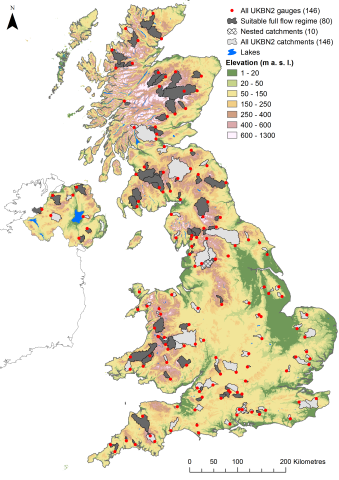The UK benchmark network (UKBN) comprises a subset of gauging stations from the national hydrometric network that are most suited for identification and interpretation of long-term hydrological variability and change. Benchmark catchments can be considered reasonably free from human disturbances such as urbanisation, river engineering, and water abstractions, so are ‘near-natural’ and hence can be used for detection of climate-driven changes in river flow.
The UKBN was originally designated almost 15 years ago by Bradford and Marsh (2003). The first iteration of the Benchmark Network, UKBN1, included 122 catchments that met four primary criteria: i) relatively natural flow regimes, ii) good and consistent hydrometric data quality, iii) relatively long records (ideally >25 years), and iv) were representative of UK hydroclimatic conditions with good geographical coverage.
It is recognised that the benchmark criteria are stringent and not all designated stations will meet these fully. Therefore, in this second iteration, UKBN2 (Harrigan et al., 2018), each of the 146 Benchmark catchments has been assigned a score based on their benchmark suitability at low, medium, and high flows, recognising all stations cannot be benchmark across the full flow regime and provided justification. A map of the network is shown below.
More information about the network is available in the UKBN2 User Guide.
See the list of UKBN2 stations, their qualifying comments and some metadata. If you would like to access data for all (or a subset of) UKBN2 stations, please contact the NRFA.

Catchment boundaries and gauging station locations for all 146 UKBN2 stations (gauges dots and grey catchments), 80 stations suitable for analysis across the full flow regime (i.e., benchmark score = 6) (dark grey catchments), with 10 nested catchments hatched (source: Harrigan et al., 2018)
